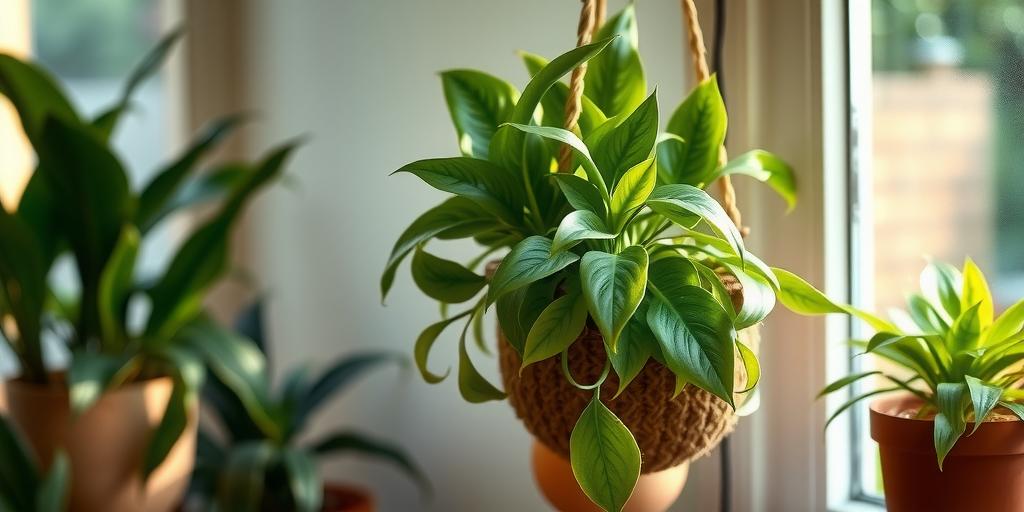
Best Air-Purifying Low Light Hanging Plants for Your Home
Discover the best air-purifying low light hanging plants to enhance your home’s air quality and aesthetics! Perfect for beginners and plant lovers alike—find easy-care options that thrive in dim spaces.
Introduction
Did you know indoor air can be up to 5 times more polluted than outdoor air? Luckily, nature has a solution! Low light hanging plants not only add greenery to your space but also filter toxins, making your home healthier and more vibrant. Whether you have a dimly lit apartment or just want to spruce up a shady corner, these plants are perfect for you. Let’s explore the best air-purifying, low-maintenance hanging plants that thrive even without direct sunlight!
Why Choose Air-Purifying Low Light Hanging Plants?
Benefits of Air-Purifying Plants for Indoor Spaces
If you’ve ever felt like the air in your home is a little stale, you’re not alone. Indoor air can be filled with pollutants like formaldehyde, benzene, and even mold spores—especially in tightly sealed modern homes. That’s where air-purifying plants come in. These green wonders don’t just look pretty; they actively filter toxins from the air, making your space healthier. Studies, including NASA’s famous Clean Air Study, have shown that certain plants can significantly reduce indoor air pollution.
How Low Light Plants Adapt to Dim Environments
Not every room in your home gets bright, direct sunlight—and that’s okay! Low light plants have evolved to thrive in shaded conditions, often under dense forest canopies where sunlight is scarce. They typically have larger, broader leaves to maximize light absorption and slower growth rates, meaning they don’t demand as much energy. This makes them perfect for dim corners, north-facing windows, or rooms with artificial lighting.
Why Hanging Plants Are Ideal for Small Spaces and Home Décor
Hanging plants are a game-changer for small spaces. Instead of taking up precious floor or shelf space, they add greenery vertically, making rooms feel more open. They also draw the eye upward, creating visual interest and a sense of height. Plus, hanging plants can soften harsh lines in modern décor, adding a touch of nature’s elegance. Whether you’re in a tiny apartment or just looking to refresh your space, hanging plants are a stylish and practical choice.
Top Air-Purifying Low Light Hanging Plants
Spider Plant (Chlorophytum comosum) – Removes Formaldehyde, Easy to Grow
The spider plant is a classic for a reason. It’s incredibly resilient, thrives in low light, and is a champion at removing formaldehyde from the air—a common toxin found in household products. Its arching leaves and tiny “spiderettes” make it a visually appealing choice for hanging baskets. Plus, it’s forgiving if you forget to water it now and then.
Pothos (Epipremnum aureum) – Filters Benzene, Thrives in Low Light
Pothos, also known as devil’s ivy, is nearly indestructible. It grows well in low light and is excellent at filtering benzene, a chemical found in plastics and synthetic fibers. Its trailing vines can grow several feet long, making it perfect for hanging planters where its lush foliage can cascade down beautifully.
English Ivy (Hedera helix) – Reduces Mold and Airborne Toxins
English ivy isn’t just for outdoor gardens—it’s a powerful air purifier indoors, too. Research suggests it can reduce airborne mold and toxins like formaldehyde and benzene. It loves cooler temperatures and indirect light, making it a great choice for bathrooms or bedrooms. Just be sure to keep it trimmed, as it can grow vigorously!
Philodendron Heartleaf (Philodendron hederaceum) – Low-Maintenance, Great for Beginners
If you’re new to houseplants, the heartleaf philodendron is a fantastic starter plant. It tolerates low light well and has heart-shaped leaves that trail elegantly from hanging baskets. It’s also effective at removing indoor air pollutants, making it as functional as it is beautiful.
Parlor Palm (Chamaedorea elegans) – Adds Tropical Vibes While Purifying Air
For a touch of the tropics, the parlor palm is a great pick. It thrives in low to moderate light and helps filter out pollutants like formaldehyde and benzene. Its feathery fronds add a soft, graceful look to any space, making it a stylish addition to hanging planters.
Care Tips for Low Light Hanging Plants
Watering Guidelines to Prevent Over/Underwatering
One of the biggest mistakes with hanging plants is improper watering. Since they’re elevated, they dry out faster than floor plants—but overwatering can still be an issue. A good rule of thumb is to check the soil: if the top inch feels dry, it’s time to water. Always ensure your pots have drainage holes to prevent root rot.
Best Soil Types for Optimal Growth
Low light plants generally prefer well-draining soil to avoid waterlogged roots. A mix of potting soil with perlite or orchid bark works well for most varieties. For plants like pothos and philodendrons, a standard indoor potting mix is usually sufficient.
How to Fertilize Without Harming the Plant
Since low light plants grow slower, they don’t need frequent fertilizing. A diluted, balanced liquid fertilizer every 4-6 weeks during the growing season (spring and summer) is usually enough. Avoid fertilizing in winter when growth slows down.
Pruning and Maintenance for Long-Lasting Health
Regular pruning keeps your hanging plants looking full and healthy. Trim yellow or dead leaves to encourage new growth and prevent disease. For trailing plants like pothos, occasional trimming can promote bushier growth rather than long, leggy vines.
Best Places to Hang Your Plants for Maximum Impact
Ideal Spots in Living Rooms, Bathrooms, and Bedrooms
-
Living rooms: Hang plants near windows (but out of direct sunlight) or in corners to add life to the space.
-
Bathrooms: Many low light plants, like English ivy, love the humidity from showers.
-
Bedrooms: Place air-purifying plants like spider plants or parlor palms near your bed for cleaner air while you sleep.
Creative Hanging Ideas (Macramé, Shelves, Ceiling Hooks)
-
Macramé hangers: Add a boho touch while keeping plants at eye level.
-
Floating shelves: Perfect for arranging multiple small hanging plants in a cluster.
-
Ceiling hooks: Great for creating a “green curtain” effect with long-trailing plants.
How to Avoid Common Placement Mistakes
Avoid hanging plants directly above electronics or in high-traffic areas where they might get bumped. Also, steer clear of heating vents or drafty windows, as sudden temperature changes can stress plants.
Common Problems & Solutions
Yellowing Leaves and How to Fix Them
Yellow leaves can signal overwatering, underwatering, or poor drainage. Check the soil moisture and adjust your watering schedule. If the plant is near a cold draft or too much direct light, consider relocating it.
Pest Control for Indoor Hanging Plants
Common pests like spider mites or mealybugs can attack hanging plants. Wipe leaves with a damp cloth or use neem oil as a natural pest deterrent. Isolate infested plants to prevent spreading.
Signs Your Plant Needs More (or Less) Light
-
Leggy growth or small leaves: Your plant likely needs more light.
-
Brown, scorched leaves: It’s getting too much direct sunlight.
-
Slow growth or no new leaves: The light may be too low—try moving it closer to a window.
By paying attention to these signs, you can keep your hanging plants thriving and your indoor air fresh!
Conclusion
Transforming your home with air-purifying low light hanging plants is an easy and stylish way to boost air quality and add natural beauty. From the resilient Spider Plant to the elegant English Ivy, there’s a perfect plant for every space. Ready to breathe cleaner air? Pick your favorite and start hanging today!
